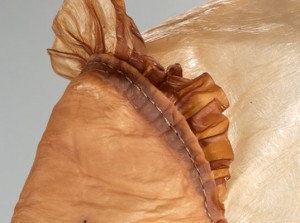The Head of Press in the UK’s House of Lords sent me (it wasn’t addressed personally so I imagine I’m on a mailing list) an embargoed communication yesterday. (I was thrilled.) It was also an invitation to watch a live stream of the debate in the House of Lords about the Nanotechnologies and Food: Science and Technology Committee Report. (I’ve commented on both the report [January 7, 2010 posting] and the government’s response [March 29, 2010 posting].)
Sadly I wasn’t able to watch the debate in real-time (browser issues and my technical illiteracy) but, happily, a transcript is available here.
I have a few tidbits from the transcript, the first from Lord Krebs who’s presenting the report,
Nanotechnology is the study of the very small. It involves manipulating matter on the scale of atoms or molecules. If you are like me, you may find it difficult to get your mind around just how small “small” means. Let me give you an idea. It is sometimes claimed that medieval scholars such as Duns Scotus and Thomas Aquinas debated the question of how many angels can fit on the head of a pin or even the point of a needle. The authenticity of this claim is disputed, although in 1667 Richard Baxter, in his tract The Reasons of the Christian Religion, definitely refers to such a debate. If we move from angels to nanoparticles, how many could you fit on the head of a pin? The answer is 300 million nanoparticles, each 100 nanometres in diameter. Alternatively, your Order Paper is roughly 100,000 nanometres thick. A further day-to-day illustration to make the point for noble Lords present is that their beards will have grown by roughly 200 nanometres since I started speaking. That is not a personal statement but a general phenomenon. [emphases mine]
It’s hard to imagine a contemporary Canadian politician making references to contested medieval theological debates as a segue to a discussion about nanoparticles and the nanoscale.
Lord Krebs goes on make this statement,
Our proposal, based on the evidence we heard, was that, for regulatory purposes, the definition of nanoparticles should focus not on size alone-after all, size is not everything-but also on functionality; that is, how the nanoscaled material interacts with the human body. The key question for risk assessment and therefore for regulation is whether nanoscaling a material changes its properties in such a way as to have a potentially toxic effect on the body. We urge the Government in our report to take forward this matter of definition in Europe. [emphasis mine]
The comment about the definition sprang out as this issue seems to be at the forefront of many recent discussions on nanotechnology. Fern Wickson and her colleagues highlight the importance of the issue in their recently published paper,
Both the beginning and the end of this range remain subject to debate. Some claim that it should extend as low as 0.1nm (because atoms and some molecules are smaller than 1nm) and as high as 300nm (because the unique properties of the nanoscale can also be observed above 100nm). The boundaries of ‘the nanoscale’ are highly significant in both scientific and political terms because they have the possibility to affect everything from funding, to risk assessment and product labelling. [my commentary, Wickson’s response, and a citation for the paper, etc. can be found in my July 7, 2010 posting]
There are currently new nanomaterial definitions before the US House of Representatives in one bill and the US Senate in another bill. The House bill specifies (excerpted from my posting of April 27, 2010 where I highlighted a discussion taking place on Andrew Maynard’s’ 2020 science blog),
“The term ‘substance characteristic’ means, with respect to a particular chemical substance, the physical and chemical characteristics that may vary for such substance, and whose variation may bear on the toxicological properties of the chemical substance, including—
(A) chemical structure and composition
(B) size or size distribution
(C) shape
(D) surface structure
(E) reactivity; and
(F) other characteristics and properties that may bear on toxicological properties”
The definitions for nanomaterials/nanoparticles and the defined ranged for the nanoscale have, as Wickson points out, implications for funding, risk assessment, and labelling.
In Canadian terms, there is the Health Canada Interim Policy Statement on [a] Working Definition for Nanomaterialswhich defines the nanoscale as 1 to 100 nm and there is Peter Julian’s tabled bill which defines the nanoscale as 1 to 1000 nm. Neither definition mentions any property other than size. From the Health Canada web page for the interim policy statement,
For the purposes of this definition:
* The term “nanoscale” means 1 to 100 nanometres, inclusive;
* The term “nanoscale phenomena” means properties of the product, material, substance, ingredient, device, system or structure which are attributable to its size and distinguishable from the chemical or physical properties of individual atoms, individual molecules and bulk material; and,
* The term “manufactured” includes engineering processes and control of matter and processes at the nanoscale. [emphases mine]
As for Peter Julian’s proposed definition (excerpted from my March 24, 2010 posting),
The following are the key components of Bill C-494:
A) A definition of Nanotechnology definition based on “nanometre scale” (1-1000nm)
B) Prescribed Government of Canada research and studies, with the precautionary principle providing direction for a ‘life-cycle’ approach to nanotechnology, and,
C) A Nanotechnology Inventory established and published.
In my July 6, 2010 posting I noted the recent report to the European Parliament for setting a regulatory framework advised this,
The report discusses possible elements of a definition aiming at reducing ambiguity and confusion for regulators, industry and the general public. It recommends that the specific term “particulate nanomaterial” should be employed in legislation to avoid inconsistencies with other definitions and that size should be used as the only defining property.
As I noted July 6, I am not thrilled with the idea of limiting the definitions to size only as I believe it will lead to problematic implementation for the legislation.
Back to the task at hand, i.e., offering samples from the UK House of Lords debate. There’s this from,
The Earl of Selborne: My Lords, the whole House will be grateful to the noble Lord, Lord Krebs. It is not easy to explain just how small a nanoparticle is, but I think he put that into perspective. I am enlightened to know that you can get 300 million nanoparticles on the head of a pin; that is a useful bit of information. Noble Lords will gather that we were very well served by our Chairman; I was very privileged to serve on this sub-committee. The noble Lord, Lord Krebs, with his experience at the Food Standards Agency, could not have been better equipped to undertake the chairing of this really quite complicated but very important subject. [emphasis mine]
A little sarcasm, eh? More seriously, he had this to say,
I ask my noble friend the Minister not for more money-that would clearly be unreasonable-but simply for the considerable sums of money that are spent on nanotechnology research to be partially reallocated, even in small measure, so that the health and safety issues are adequately addressed. The amount of money that we are talking about is very small compared with the development of these new technologies.
In 2007-08 I chaired a working group of stakeholders charged with drafting a voluntary code on good practice for organisations involved in the supply chain for nanotechnologies. The group included research organisations such as the Royal Society through to retailers, trade unions, consumer groups, and of course companies interested in nanotechnologies. We produced a draft nano code that was accepted with a degree of enthusiasm by all the stakeholders. The repeated mantra in all this was “Transparency, accessibility and accountability”-you cannot repeat it too often. Never hide from the public any shortcomings in the scientific knowledge-there are always some. Never try to persuade the public that the risks are less than might otherwise be thought. Be honest. This is something that the Food Standards Agency got off to a good start with after so many food scares when the regulatory authority was the Ministry of Agriculture, Fisheries and Food.
It is disappointing to find that this fundamental lesson does not appear to have been adopted by the food industry, either here or in America.
From Baroness O’Neill of Bengarve,
The questions that are raised by the introduction of new technologies-in particular very novel technologies that are not well understood-into food processing link basic and applied scientific research, knowledge transfer, innovation in manufacturing, the fate of a very large part of the British economy and the daily consumption of food by each one of us. The human and economic consequences of getting matters wrong could be large, ranging from failure to adopt food technologies that may be useful for human health, to failure to co-ordinate work on the scientific basis of nanotechnologies, to failure to build on the achievements of UK scientists, to a considerable loss of competitive advantage by the UK food processing industry, not to mention the possibility of failure to adjust regulation to focus accurately on the risk assessment that will be needed.
I am no friend of excessive regulation, and like many who have run a small institution, I know its costs all too well. However, there are cases in which laissez-faire and market solutions will not work. Public health is a public good, often not achievable by the interplay of market forces and consumer choice alone. The long-running battle between the FSA and the food industry over labelling illustrates-if it illustrates nothing else-that there are those in the food industry who prefer to communicate, or at least pretend to communicate, in ways that demonstrably are not understood by many consumers and indeed may not be comprehensible to many consumers. Mere labelling will not be enough to secure public acceptance of food products containing nanoparticles, despite the fact that nanoparticles are found in many naturally occurring products, including traditional foods-and the sub-committee was told that ricotta cheese contains many of them. We need a more thoughtful approach.
Lord Crickhowell had these comments,
Finally, I say how strongly we felt-this has been said by other noble Lords-about the importance of the industry being open about what it is doing and positive in its communication with the public. The evidence that we received was depressing. Large firms that should have learnt lessons from the GM disaster, for a variety of reasons, seemed to be continuing down the route that led to the disaster. If they do not trust the public, the public will not trust them. The New Scientist, in May, contained a report that stated that a Unilever spokesperson,
“won’t say what nanofoods Unilever is looking into. Two other food multinationals, Kraft and Nestle, declined to talk about their research in the area at all”.
Nothing seems to have changed.
My honourable friend David Willetts, the science Minister who gave evidence earlier today to the Science and Technology Committee, made an interesting observation in his recent speech delivered to the Royal Institution. He was not talking about nanotechnology, but synthetic biology. He said:
“The UK Research Councils had the foresight to hold a public dialogue about ramifications of synthetic biology ahead of Craig Venter developing the first cell controlled by synthetic DNA. This dialogue showed that there is conditional public support for synthetic biology. There is great enthusiasm for the possibilities associated with this field, but also fears about controlling it and the potential for misuse”.
Those words could be applied exactly to nanotechnology and the evidence we received from Which? [UK public engagement project] confirmed it.
There’s more in the Hansard and I found it to be quite interesting as others comment on differences between the UK and the US and there’s more discussion about the implications of the technology and the food industry’s secrecy in light of GMO (genetically modified organisms) and synthetic biology.



